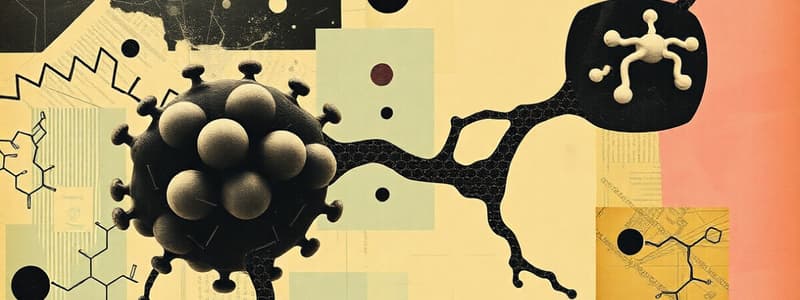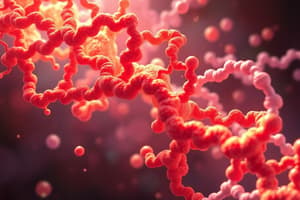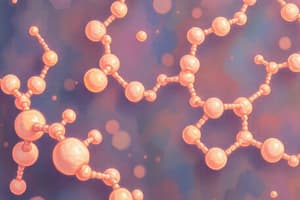Podcast
Questions and Answers
Which of the following is NOT a primary function of proteins within biological systems?
Which of the following is NOT a primary function of proteins within biological systems?
- Structural support
- Genetic information storage (correct)
- Transport of molecules
- Catalysis of reactions
All amino acids found in proteins exist in both D and L forms.
All amino acids found in proteins exist in both D and L forms.
False (B)
What type of bond links amino acids together in a protein?
What type of bond links amino acids together in a protein?
peptide bond
Amino acids in water exist as ______, which carries both positive and negative charges.
Amino acids in water exist as ______, which carries both positive and negative charges.
Match the amino acid property with its corresponding category:
Match the amino acid property with its corresponding category:
What makes each protein unique?
What makes each protein unique?
Carbohydrates are polymers composed of amino acids.
Carbohydrates are polymers composed of amino acids.
Name the four main categories of biomolecules discussed in Lecture 2.
Name the four main categories of biomolecules discussed in Lecture 2.
The central alpha-carbon in an amino acid is bonded to an amino group, a carboxyl group, a hydrogen atom, and a(n) ________.
The central alpha-carbon in an amino acid is bonded to an amino group, a carboxyl group, a hydrogen atom, and a(n) ________.
Match the following roles with the corresponding example proteins:
Match the following roles with the corresponding example proteins:
Which statement correctly describes the nature of peptide bonds?
Which statement correctly describes the nature of peptide bonds?
The N-terminus of a peptide chain refers to the carboxyl group end.
The N-terminus of a peptide chain refers to the carboxyl group end.
What two elements are contained within Cysteine and Methionine?
What two elements are contained within Cysteine and Methionine?
The only amino acid which is cyclic in structure is _________
The only amino acid which is cyclic in structure is _________
Match the one-letter code next to the three-letter coding
Match the one-letter code next to the three-letter coding
What is the average molecular mass of amino acids?
What is the average molecular mass of amino acids?
Additional Amino Acids can added onto the amino end
Additional Amino Acids can added onto the amino end
What is the start of peptide chain referred to as?
What is the start of peptide chain referred to as?
The dehydration results in the removal of ______
The dehydration results in the removal of ______
Match the following categories of R-groups with the number of Amino Acids falling in those groups:
Match the following categories of R-groups with the number of Amino Acids falling in those groups:
Flashcards
What are Proteins?
What are Proteins?
Polymers composed of amino acids. They perform various functions like structure, catalysis (enzymes), transport (hemoglobin), and defense (antibodies).
What is the role of Enzymes?
What is the role of Enzymes?
Catalysis of reactions inside and outside cells.
What is the role of Antibodies?
What is the role of Antibodies?
Defense mechanism within the immune system.
What's the Basic Amino Acid Structure?
What's the Basic Amino Acid Structure?
Signup and view all the flashcards
What are Stereoisomers (L and D forms)?
What are Stereoisomers (L and D forms)?
Signup and view all the flashcards
What is Amino Acid Charge?
What is Amino Acid Charge?
Signup and view all the flashcards
What are Hydrophobic Amino Acids?
What are Hydrophobic Amino Acids?
Signup and view all the flashcards
What are Hydrophilic Amino Acids?
What are Hydrophilic Amino Acids?
Signup and view all the flashcards
What is special about Proline?
What is special about Proline?
Signup and view all the flashcards
What is a Peptide Bond?
What is a Peptide Bond?
Signup and view all the flashcards
What is a Peptide?
What is a Peptide?
Signup and view all the flashcards
What are N-terminus and C-terminus?
What are N-terminus and C-terminus?
Signup and view all the flashcards
What are proteins?
What are proteins?
Signup and view all the flashcards
How do amino acids form peptide chains?
How do amino acids form peptide chains?
Signup and view all the flashcards
How does composition affect function?
How does composition affect function?
Signup and view all the flashcards
Study Notes
Protein Basics
- The basic categories include Proteins, Carbohydrates, Lipids, and DNA/RNA
- Focus is given to what they are and what their structure is, including chemical and physical make-up, bonds and folding
Proteins
- Perform many functions in the body
- These functions range from structure and support to catalysis of reactions, transport, defense, development and regulation, and movement
- Examples of proteins includes collagen, elastin, enzymes, hemoglobin, antibodies, cytokines, hormones, and myosin
- Enzymes and antibodies have industrial applications and medical uses as drugs
Protein Structure
- Proteins are polymers of amino acids
- There are 20 different amino acids commonly found in proteins
- Proteins are formed by joining amino acids together in a long linear chain
- What makes each protein unique is the order and number of the amino acids in the polypeptide chain
- The number of possibilities = 25,600,000,000
Amino Acids
- Amino acids have a common structure and are building blocks for proteins
- The central carbon (α-carbon) is bonded to an amino group (NH2), a carboxyl group (COOH), hydrogen, and a side chain or R-group
- The R-group is what varies among the 20 different amino acids
Stereoisomers
- Amino acids are stereoisomers
- The central α-carbon is chiral, forming an asymmetric molecule
- Amino acids can have 2 different stereoisomers: L and D forms
- All amino acids (except Glycine) exist in D and L forms
- Only L-forms are found in proteins
Amino Acids and Charge
- In water, amino acids are ionized and exist as dipolar ions (zwitterions)
- In this situation, NH2 becomes NH3+ and COOH becomes COO-
- R-groups can also contribute charge and some are highly charged
- Overall charge on the protein is determined by the sequence of amino acids
- Overall charge affects the shape of a protein
R-Groups in Amino Acids
- 20 different R-groups give rise to the 20 different amino acids
- R-groups are divided into nonpolar (uncharged and hydrophobic), polar (uncharged and hydrophilic), and charged at cellular pH
- 9/10 are nonpolar ex. Alanine
- 5/6 are polar ex. Cysteine
- 5 are charged ex. Lysine
- Proline is the only amino acid that is cyclic
- Cysteine and Methionine contain sulphur
Protein Code
- Each amino acid has a three letter code and one letter code abbreviation
Peptide Bonds
- Amino acids are joined together to form chains through peptide bonds
- A peptide bond occurs between the carboxyl group of one amino acid and the amino group of another
- Dehydration (condensation) reactions result in the removal of H2O
- Resulting bond is covalent (C-N), peptide bond, and quite rigid
- Additional amino acids can be added at the carboxyl end
Peptides
- Peptide is a short sequence (chain) of amino acids, generally less than 50 amino acids
- A chain of 2 amino acids is a di-peptide, 3 is a tri-peptide, etc
- The start of a peptide chain is the N-terminus (amino group) and the end is the C-terminus (carboxyl group)
- The backbone sequence is N-C-C (nitrogen, carbon, carbon) with R-groups attached to carbon
Polypeptides
- Polypeptides have a larger number of amino acids joined to form chains
- The number of amino acids varies between 50 to over 1000
- Some proteins consist of several polypeptide chains linked together
- The unit of size for proteins is called Dalton (Da)
- 1 Da = one atomic mass unit
- The molecular weight of amino acids varies from 75 Da for Glycine to 186 Da for Tryptophan; average = ~120 Da
- The molecular weight of proteins can vary from 1,000 to >100,000 Daltons (1kDa to >100kDa)
Peptide Drugs
- The market for peptide drugs is >$45 billion
- There are currently >100 peptide drugs on the market with more in clinical trials
- Oxytocin has 9 amino acids and is used for inducing labor (produced synthetically)
- Many peptide drugs are isolated from natural sources or by semi-synthetic modification of natural material
Summary of Protein Info
- Proteins are polymers composed of amino acids
- The basic structure of an amino acid contains an amino group, a carboxylic acid group (common), and an R-group (unique)
- Amino acids contain both positive and negative charge
- There are 20 standard amino acids with 20 R-groups that vary in size and charge
- Depending on the R group, amino acids can be hydrophobic or hydrophilic
- Amino acids are joined together via peptide bonds
- Amino acids form peptide chains which begin at the N-terminus and end at the C-terminus
- The shape and charge (and therefore function) of a protein is related to the composition and order of amino acids
Studying That Suits You
Use AI to generate personalized quizzes and flashcards to suit your learning preferences.




